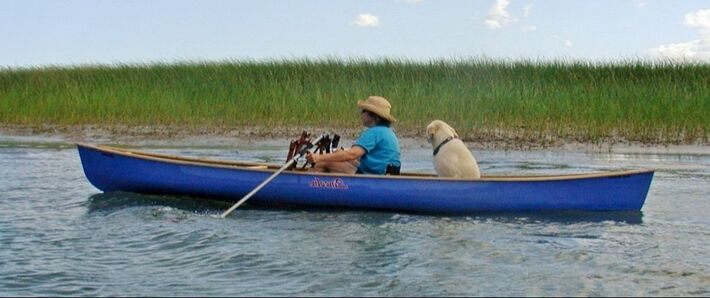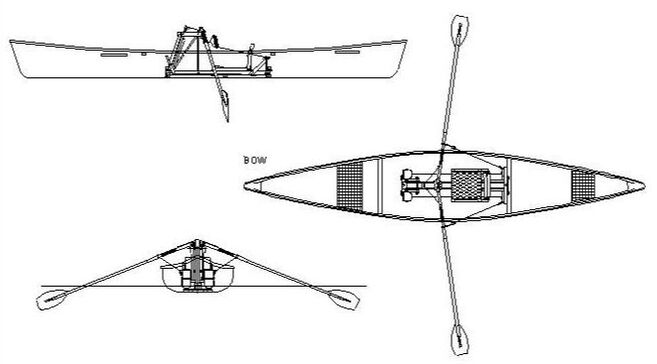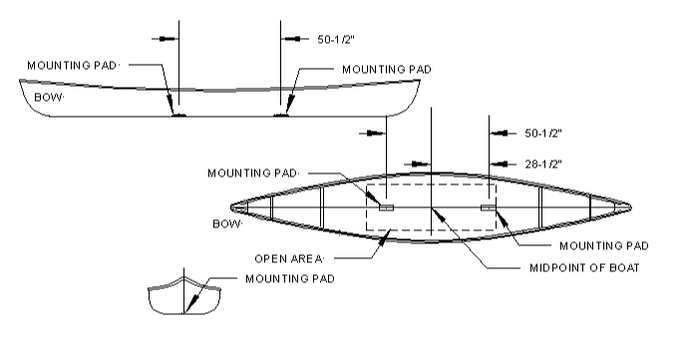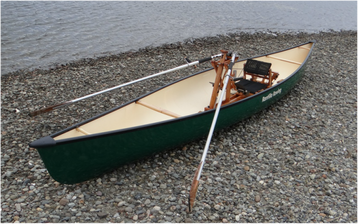Rowing Canoes
Most ordinary tandem recreational or touring canoes will make excellent rowboats. If you already own a canoe, there's a good chance you can convert it for rowing with the FrontRower™ drop-in rowing system. See types of canoes and recommended models below.
Typical Installation
Installation involves locating the correct position for the rowing station in the boat, and then gluing two mounting pads to the floor of the boat to hold the rowing station in that position.
There needs to be enough open area for the frame and seat to fit in, and for the pedals to operate. This needs to be 60" long and 16" wide at the bottom, 26" wide at the top.
For a basic one-position installation you can remove the center thwart and leave everything else (seats and additional thwarts) in place. This should give you enough area to position the rowing unit. In some canoes it may be necessary to reposition or add thwarts for structural integrity.
For rowing with a passenger, see drawings page.
Types of Canoes
Tandem canoes
Tandem canoes designed for casual recreation, touring or cruising make the best rowing canoes. These will typically be between 15 and 17 feet long with a beam (the maximum width) of between 32 and 36 inches. This type of canoe will have room for one rower with or without a passenger.
Solo canoes
Some solo canoes work well for rowing, as long as they have at least 26 inches between the gunwales at the center. Solo canoes will not have room for a passenger.
Specialized canoes
Canoes designed for whitewater are not suitable for rowing. Sportsman's canoes intended for hunting and fishing may work, but if less than 14 feet long will not have much hull speed. You could try it if you you already own one, but don't buy one for rowing.
Canoe construction
The biggest difference in construction materials is in the weight of the canoe. Materials from lightest to heaviest are: carbon fiber, kevlar, aluminum, wood, fiberglass, and roto-molded plastics. The same size canoe can weigh anywhere from 30 to 90 pounds. This doesn't make too much difference in the water, but it makes a big difference when you are moving it around on land or trying to car-top it. Our preference is for kevlar, which can give you a tandem touring canoe weighing around 40 pounds - light enough to be easily car topped.
Tandem canoes designed for casual recreation, touring or cruising make the best rowing canoes. These will typically be between 15 and 17 feet long with a beam (the maximum width) of between 32 and 36 inches. This type of canoe will have room for one rower with or without a passenger.
Solo canoes
Some solo canoes work well for rowing, as long as they have at least 26 inches between the gunwales at the center. Solo canoes will not have room for a passenger.
Specialized canoes
Canoes designed for whitewater are not suitable for rowing. Sportsman's canoes intended for hunting and fishing may work, but if less than 14 feet long will not have much hull speed. You could try it if you you already own one, but don't buy one for rowing.
Canoe construction
The biggest difference in construction materials is in the weight of the canoe. Materials from lightest to heaviest are: carbon fiber, kevlar, aluminum, wood, fiberglass, and roto-molded plastics. The same size canoe can weigh anywhere from 30 to 90 pounds. This doesn't make too much difference in the water, but it makes a big difference when you are moving it around on land or trying to car-top it. Our preference is for kevlar, which can give you a tandem touring canoe weighing around 40 pounds - light enough to be easily car topped.
Recommended Canoe Models
There are many canoe models from various manufacturers that can be set up to work with the FrontRower. Some models that are known to work well are listed below.
For solo rowing with room for a passenger:
Wenonah Adirondack, length: 16'-0", max beam: 36"
Bell North Star, length: 16'-6", max beam: 34-1/2"
Mad River Malecite, length: 16'-6", max beam: 34-1/2"
For solo only rowing (no passenger):
Wenonah Prism, length: 16'-6", max beam: 30-3/4"
For doubles Rowing:
For two rowing stations, you will need a longer boat, around 18 feet:
We can't recommend any canoes, but the Odyssey 18™ touring rowboat is a great doubles rowing boat.
For solo rowing with room for a passenger:
Wenonah Adirondack, length: 16'-0", max beam: 36"
Bell North Star, length: 16'-6", max beam: 34-1/2"
Mad River Malecite, length: 16'-6", max beam: 34-1/2"
For solo only rowing (no passenger):
Wenonah Prism, length: 16'-6", max beam: 30-3/4"
For doubles Rowing:
For two rowing stations, you will need a longer boat, around 18 feet:
We can't recommend any canoes, but the Odyssey 18™ touring rowboat is a great doubles rowing boat.




